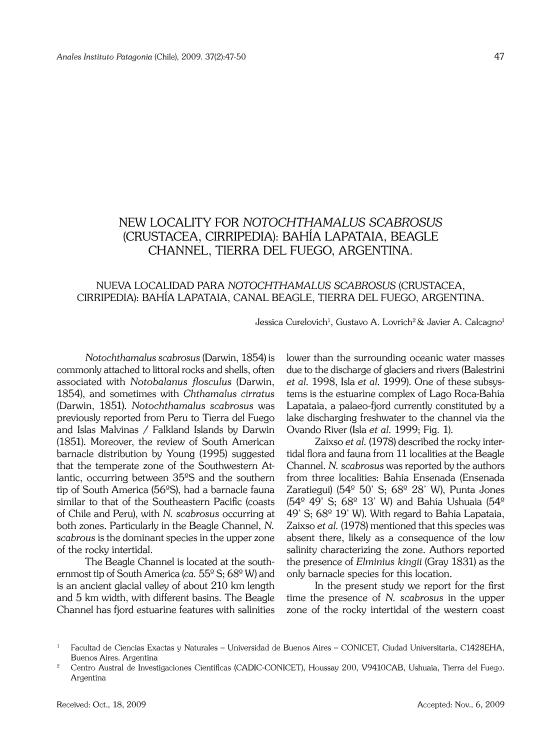Mostrar el registro sencillo del ítem
dc.contributor.author
Curelovich, Jessica Natalia

dc.contributor.author
Lovrich, Gustavo Alejandro

dc.contributor.author
Calcagno, Javier Ángel

dc.date.available
2021-03-16T17:48:59Z
dc.date.issued
2009-12
dc.identifier.citation
Curelovich, Jessica Natalia; Lovrich, Gustavo Alejandro; Calcagno, Javier Ángel; New locality for Notochthamalus scabrosus (Crustaces, Cirripedia): Bahia Lapataia, Beagle Channel, Tierra del Fuego, Argentina; Universidad de Magallanes; Anales del Instituto de la Patagonia; 37; 2; 12-2009; 47-50
dc.identifier.issn
0718-686X
dc.identifier.uri
http://hdl.handle.net/11336/128392
dc.description.abstract
Notochthamalus scabrosus (Darwin 1854) is commonly attached to littoral rocks and shells, often associated with Notobalanus flosculus (Darwin 1854), and sometimes with Chthamalus cirratus (Darwin 1851). Notochthamalus scabrosus was previously reported from Peru to Tierra del Fuego and Islas Malvinas / Falkland Islands by Darwin (1851). Moreover, the review of South American barnacle distribution by Young (1995) suggested that the temperate zone of the Southwestern Atlantic, occurring between 35ºS and the southern tip of South America (56ºS), had a barnacle fauna similar to that of the Southeastern Pacific (coasts of Chile and Peru), with N. scabrosus occurring at both zones. Particularly in the Beagle Channel, N. scabrous is the dominant species in the upper zone of the rocky intertidal. The Beagle Channel is located at the southernmost tip of South America (ca. 55º S; 68º W) and is an ancient glacial valley of about 210 km length and 5 km width, with different basins. The Beagle Channel has fjord estuarine features with salinities lower than the surrounding oceanic water masses due to the discharge of glaciers and rivers (Balestrini et al. 1998; Isla et al. 1999). One of these subsystems is the estuarine complex of Lago Roca-Bahía Lapataia, a palaeo-fjord currently constituted by a lake discharging freshwater to the channel via the Ovando River (Isla et al. 1999; Fig. 1). Zaixso et al. (1978) described the rocky intertidal flora and fauna from 11 localities at the Beagle Channel. N. scabrosus was reported by the authors from three localities: Bahía Ensenada (Ensenada Zaratiegui) (54º 50? S; 68º 28 W), Punta Jones (54º 49? S; 68º 13 W) and Bahía Ushuaia (54º 49? S; 68º 19 W). With regard to Bahía Lapataia, Zaixso et al. (1978) mentioned that this species was absent there, likely as a consequence of the low salinity characterizing the zone. Authors reported the presence of Elminius kingii (Gray 1831) as the only barnacle species for this location. In the present study we report for the first time the presence of N. scabrosus in the upper zone of the rocky intertidal of the western coast of Bahía Lapataia (54º 51.54? S, 68º 33.87? W), Tierra del Fuego (Fig. 1). Specimens of N. scabrosus were found along with Elminius kingii (Fig. 2). On September 25th, 2008 photographs and samples of both species were taken. The samples were collected for accurate identification after dissection. Especially during spring and summer, Ensenada Zaratiegui and Bahía Lapataia have very variable and lower salinity than other sites of the Beagle Channel, which in turn are less influenced by freshwater discharges (Table 1). N. scabrous is clearly a euryhaline species since specimens can tolerate a range of salinities of 15 31 ups. Although there are no specific studies on salinity tolerance of this species, the genus Chthamalus is known to be euryhaline (e.g. Crisp & Costlow 1963, López & González 2003, Farrapeira 2008). Roughgarden et al. (1988) and Alexander & Roughgarden (1996) have suggested that the ecology of a rocky intertidal community at a site would be governed by adult-adult interactions within the site, or by limitations to the supply of larvae reaching the site, the latter being determined by the regional pattern of circulation and physical oceanography in the coastal waters. These characteristics would explain the variation of timing of recruitment at the coast and the likely reason that it occurs in discrete pulses. We propose that the establishment of N. scabrosus in Bahía Lapataia could be a consequence of local hydrological events, namely coastal currents, wind direction and intensity and availability of larvae in the plankton rather than by the low saline waters characterizing the zone, and these events would explain the discontinuous scheme of distribution of N. scabrosus along the coast of the Beagle Channel. This channel is a particular environment because of its fjord features and its semi-closed condition (Antezana 1999). For example, the freshwater input may change the environmental conditions at a geographical micro-scale. In some western coves the ice input from glaciers may produce the typical coastal disturbance so that the intertidal community may be locally impoverished or absent (c.f. Mutschke & Gorny 1999; Barnes 2005). Hence, the presence of certain species at different sites with both different freshwater input and coastal orientation and therefore differentially affected by winds and currents may be indicators of specific hydrological processes acting on the community structure and/or diversity.
dc.format
application/pdf
dc.language.iso
eng
dc.publisher
Universidad de Magallanes
dc.rights
info:eu-repo/semantics/openAccess
dc.rights.uri
https://creativecommons.org/licenses/by-nc-sa/2.5/ar/
dc.subject
distribución
dc.subject
cirripedios
dc.subject
atlántico sur
dc.subject
fiordos
dc.subject.classification
Biología Marina, Limnología

dc.subject.classification
Ciencias Biológicas

dc.subject.classification
CIENCIAS NATURALES Y EXACTAS

dc.title
New locality for Notochthamalus scabrosus (Crustaces, Cirripedia): Bahia Lapataia, Beagle Channel, Tierra del Fuego, Argentina
dc.title
Nueva localidad para Notochthamalus scabrosus (Crustacea, Cirripedia): Bahía Lapataia, Canal Beagle, Tierra del Fuego, Argentina
dc.type
info:eu-repo/semantics/article
dc.type
info:ar-repo/semantics/artículo
dc.type
info:eu-repo/semantics/publishedVersion
dc.date.updated
2021-03-12T19:17:57Z
dc.journal.volume
37
dc.journal.number
2
dc.journal.pagination
47-50
dc.journal.pais
Chile

dc.journal.ciudad
Punta Arenas
dc.description.fil
Fil: Curelovich, Jessica Natalia. Consejo Nacional de Investigaciones Científicas y Técnicas; Argentina. Universidad de Belgrano. Facultad de Ciencias Exactas y Naturales; Argentina
dc.description.fil
Fil: Lovrich, Gustavo Alejandro. Consejo Nacional de Investigaciones Científicas y Técnicas. Centro Austral de Investigaciones Científicas; Argentina
dc.description.fil
Fil: Calcagno, Javier Ángel. Consejo Nacional de Investigaciones Científicas y Técnicas; Argentina. Universidad de Belgrano. Facultad de Ciencias Exactas y Naturales; Argentina
dc.journal.title
Anales del Instituto de la Patagonia
dc.relation.alternativeid
info:eu-repo/semantics/altIdentifier/url/https://scielo.conicyt.cl/scielo.php?script=sci_arttext&pid=S0718-686X2009000200005
Archivos asociados
